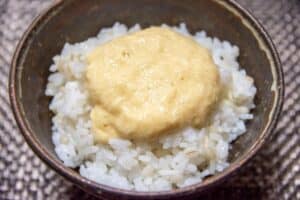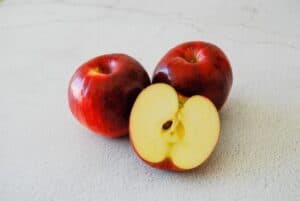Shirako, a delicacy in Japan, refers to the milt or sperm sacs of male fish, celebrated for its creamy texture and delicate flavor. It embodies Japan’s culinary philosophy of utilizing every part of the fish and respecting the gifts of the ocean. Its rich history and cultural significance make it a sought-after ingredient in Japanese cuisine, enjoyed particularly during the winter season.
What is Shirako?

Shirako (白子), popularly known, as milt or fish semen, is a highly prized delicacy in Japanese cuisine. It is the milt or sperm sacs of male fish, typically from cod, blowfish, anglerfish, and salmon. Shirako is creamy, and white, and has a mild, slightly sweet flavor often compared to oysters or scallops. It has a “silky and custard-like texture that melts in your mouth, creating a fairly unique sensory experience as you eat,” says Julian Plateado, a seafood expert from Nordic Catch. Considered to be a seasonal delicacy, with the best shirako being available during the winter months.
The name “shirako” translates to “white children,” referring to its white, creamy appearance.
Origin of Shirako in Japan

The history of eating shirako isn’t exactly clear, but it likely goes back to using all parts of the fish to avoid waste. Since whole fish were probably eaten in fishing villages, shirako consumption likely started there. Interestingly, even in cities during the Meiji period, when shirako became more common, there wasn’t any resistance. This, along with the fact that safe blowfish shirako was likely eaten even before written history, suggests shirako has been a part of Japanese cuisine for a long time.
Types of Shirako that Japanese Uses

Puffer Fish Milt
Edible varieties have minimal tetrodotoxin accumulation and offer a rich flavor. Grilled puffer fish milt is a delicacy.
Did you know about Fugu milt?
Fugu milt, the testicles of male blowfish, is considered the most valuable part of the blowfish due to its limited availability and is highly prized in Japanese cuisine. Particularly delicious during the spawning season from January to March, it becomes more expensive and harder to find as this period approaches. Commonly featured in luxurious kaiseki meals, fugu milt can be enjoyed grilled, fried, or blanched with ponzu sauce.
Salmon Milt
Primarily used in extracting DNA, protamine, and rare earths, it’s also popular in hotpots and soups during the autumn salmon season. It’s becoming pricier due to declining salmon catches since 2004.
Cod Milt
Known by various local names, it has a distinctive fold-like shape. Historically referred to as “cod intestines” in the Muromachi period, it is now used in grilled dishes, tempura, miso soup, and hot pots. Cod milt is also processed into kamaboko in Hokkaido.
Squid Milt
Rare and prized, it’s typically found in high-end restaurants, served with ponzu sauce, vinegared miso, or as fishball dumplings.
Cultural Significance

In Japan, where seafood reigns supreme, shirako embodies respect for the ocean. This unique part of the fish, often from cod but also found in tuna and pufferfish, isn’t just a delicacy, it’s a way to honor the entire catch and minimize waste. Cod, known in Japan for its superior quality, is typically preferred for Shirako. However, it is not uncommon to find this delicacy derived from other fish species like tuna and pufferfish. Local diners often celebrate Shirako during the winter, as it is considered the best season to enjoy its fresh taste.
Season of Shirako

Blowfish milt, called shirako, is a prized winter delicacy in Japan, especially in places like Shimonoseki and Osaka. Known for its rich flavor and unique texture, and because it’s only available from male blowfish during winter in limited quantities, it can be quite expensive. Traditionally enjoyed blanched with ponzu sauce or grilled, shirako can also be fried as tempura or fritters. While previously only found in restaurants, online options are now available for home cooks to enjoy this special winter treat.
Shirako FAQ
- What does shirako taste like?
-
Shirako has a delicate, creamy texture and a mild, slightly sweet flavor. It is often described as having a custard-like consistency with a subtle briny taste, reminiscent of the ocean. Its flavor is gentle, making it a versatile ingredient that can be paired with various seasonings and cooking methods without overpowering the dish.
- Are there any health benefits associated with eating shirako?
-
Shirako is a nutritious delicacy, rich in protein, vitamins, and minerals. It contains essential fatty acids, including omega-3, which are beneficial for heart health. Shirako is also low in calories and high in vitamin B12, contributing to overall well-being. However, due to its high cholesterol content, it should be consumed in moderation as part of a balanced diet.
How to prepare Shirako?

First, wash the raw milt carefully with water. The key is to wash gently to avoid damaging the delicate texture. Remove the blood and slime from the milt using running water.
Next, drain the water and cut off the strings (red parts) that connect the milt. This step is crucial as it affects the texture, so handle the milt with care. Then, cut the milt into bite-sized pieces, being gentle to prevent the insides from spilling out.
Prepare a bowl of ice water and add a little alcohol. Adding alcohol helps eliminate the “watery” feeling after cooling with water. This step ensures the milt retains its firm texture and delicate flavor.
Boil water in a pot, and once it reaches a boil, add “sashimizu” to lower the temperature to 70-80℃. Ensure the water is not boiling by cooling it down with cold water. Gently roll each milt piece in the water for about 30 to 40 seconds until cooked through. Ideally, cook one milt at a time to maintain a consistent temperature.
Once the milt is cooked, quickly place it in ice water to cool it well. Remove the moisture from the milt with kitchen paper. The milt is now prepared and can be enjoyed as is with ponzu sauce for a delicious and delicate dish.
Where to find Shirako?
Yabe (銀座矢部)

At Ginza’s famous restaurant Yabe, wintertime brings the opportunity to savor blowfish, with its highly prized milt as a highlight. While cod milt (kumoko) and fatty sakura sea bream milt are delicious, blowfish milt stands out with its delicate yet rich flavor and melt-in-your-mouth texture. Additionally, Shirako Zosui, a milt porridge made with pureed milt instead of eggs, offers a rich taste similar to risotto, making it a sophisticated treat for adult palates.
Kicho (恵比寿 希鳥)

“Kicho” is a hidden gem of a yakitori restaurant where adults can relax and enjoy yakitori and wine at the counter. If you still have room after your meal, try the “Mabo Shirako” from the a la carte menu. Made with Miyazaki chicken milt, it features a tangy finish, silky texture, and rich flavor. This winter delicacy is sure to warm you from the inside out and is a must-try.
Sushi Gotoku (鮨 五徳)

Sushi Gotoku’s specialty, “Butter-grilled Shirako,” has been a staple since the chef’s training days. This simple yet delicious dish involves grilling milt with butter and soy sauce over an open flame, highlighting the milt’s rich flavor and melt-in-your-mouth texture. The shirako is uniquely served in a custom-ordered cocotte and accompanied by bite-sized pieces of vinegared rice.
Final Thoughts

In Japan, shirako holds a special place in culinary traditions, reflecting a deep appreciation for the bounty of the sea and the artistry of cuisine. Whether enjoyed as a luxurious delicacy in high-end restaurants or savored in home-cooked meals, shirako continues to captivate taste buds with its unique flavor and texture.
You can check some Japanese unfamiliar dishes that we know you would like to try too.
















Comments